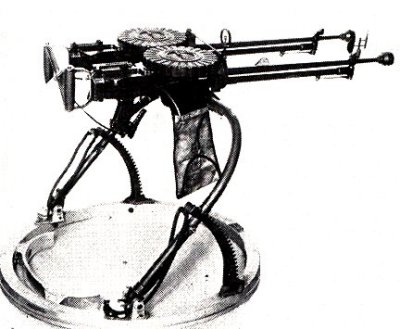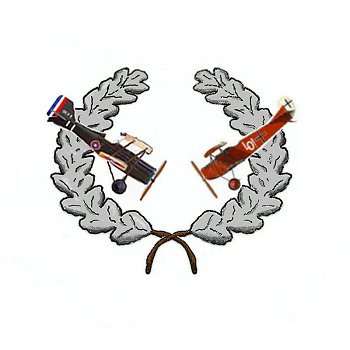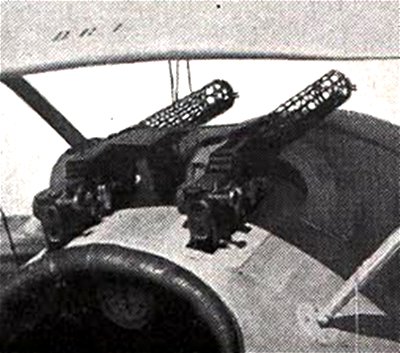Allied Machine guns for World War I Aircraft |
The primary machine guns: |

The Lewis Machine gun: Original design: USA, Samuel MacLean; Col. Isaac Lewis British Manufacturing: Birmingham Small Arms Ltd. Caliber: .303in Length: 50.5 in Weight: unloaded, 26 lbs Barrel: 26.25 in; 4 grooves left hand twist Magazine (for aerial use): 97 round "double drum" Rate of fire: 550 rpm Muzzle velocity: 2,450 fps; 745 mps Picture shows a twin Lewis on a Scarf mounting for observer use photo: "Fighter Aircraft of the 1914-1918 Air War" |
all machine gun statistics from "Military Small Arms of the 20th Century," by Hogg and Weeks, unless stated otherwise |
Left: Lewis Gun on a Foster mount, Se-5a. The pilot is changing the 97 round "double drum." This method was difficult even in the best circumstances, and the typical technique was to fly out of the fight towards one's own lines, change out the drum, and then re-engage. The Lewis was pulled from the "V" clip (far left) and pulled back on the railing. Once changed, the pilot had to push the gun forward sharply to ensure it locked back in the "V" clip. If he failed to do this, the weapon would "creep" when fired. Changing the drum required both hands, and most pilots became adept at flying with their knees! photo: "Jane's Fighting Aircraft of World War I" |
Left: Early Lewis Gun mounting on a French Nieuport 11 "Bebe." Reloading or clearing a jam on the Lewis Gun with this mounting was difficult and dangerous. Pilots would use several straps to hold the control yoke in place, then climb up, either on their knees or standing ( ! ) to change out the drum or clear the mechanism. It was a dangerous procedure, and being thrown from the plane to their death was not uncommon. One pilot, Capt. L.A. Strange, was flying a Martinsyde S.1 with this same machine gun arrangement while attacking a German two-seater. He attempted to change out the drum but it became jammed. While standing in his seat, his plane stalled and turned inverted. Strange was thrown from the cockpit and saved himself by clinging to the very ammo drum he was trying to loosen! He managed to climb back into his seat and regain control of his plane. Others were not so fortunate. photo: "Fighter Aircraft of the 1914-1918 War" |

The Vickers Machine gun: Original design: Germany, Maxim machine gun British Manufacturing: Vickers-Armstrong, Ltd. Caliber: .303in Length: 45.5 in Weight: unloaded, 40 lbs Barrel: 28.5 in; 4 grooves right hand twist Magazine (for aerial use): fabric belt fed of various lengths Rate of fire: 450 rpm Muzzle velocity: 2,450 fps; 745 mps Photo is the standard aircraft mounted version of the Vickers photo: "Fighter Aircraft of the 1914-1918 Air War" |
German Machinguns |


